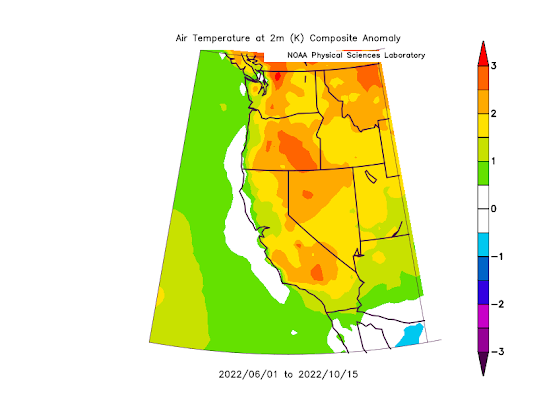The Great Wildfire Mystery and The Latest (Dry) Forecast
There is an apparent contradiction regarding wildfires and climate in the western U.S. that few have talked about. Wildfire acreage has been low even though the summer has been warm and dry for most of the region.
This year was one of the most benign wildfire years in a long time for the entire West Coast. Plotting the wildfire acreage over California since 1987 (see below) shows that the 2022 acreage burned has been quite low, similar to the situation 30 years ago.
The interesting thing is that this low-fire area situation occurred even though the west coast states have been warmer and drier than normal.
Consider the difference of this summer's (June 1-October 15) temperature from normal (1990-2010 mean)--see below. Warmer than normal for the entire coast! You would expect more fires--right?
What about precipitation and drought? Well, folks like to look at the NOAA Drought Monitor, whose November 1 graphic showed terrible drought over California and eastern Oregon, and modest drought over the rest.You would think this would encourage bountiful wildfire!
But it didn't.
How could this be?
It turns out that wildfire occurrence is much more complicated than the simple relationship between wildfires, temperature, and precipitation portrayed in some media and by some politicians.
Let's confirm this by plotting the average temperatures, precipitation and wildfire acreage over Washington from 2002 to this year (below).
2022 had the warmest summer (June through October) for the entire period by far.

But yet the wildfire acreage was very low..... again, how can this be?
The Connection Between Wildfire and Weather/Climate is More Complicated Than Often Portrayed
The connection between climate and wildfires is far more nuanced than some folks suggest. And that means the connection between global warming and wildfires is not as definitive as often claimed.
For example, strong winds are an essential component for initiating and spreading wildfires. And strong easterly winds (such as the winds that spread the recent Bolt Fire near Skykomish) are particularly important for wildfire on the western side of regional terrain barriers.
The lack of strong easterly winds this summer and fall helped keep down the fires this year. And recent research suggests that global warming may REDUCE such winds for the entire West Coast, reducing fire initiation and spread. You won't hear about that in the Seattle Times.
Most West Coast fires are initiated by humans, with poorly maintained electrical infrastructure being a major contributor. Substantial recent efforts have been given to trimming trees near power lines, hardening electrical infrastructure, and de-energizing powerlines when strong winds are forecast. This seems to be helping.
Finally, the dry conditions last winter reduced the amount of fuels available, particularly grasses, thus lessening the potential for fire.
Warmer temperatures and drier conditions do not necessarily increase fire risk significantly. The West Coast has a Mediterranean climate with very dry summers. Even a normal summer allows surface fuels (such as grasses and other light vegetation) to be dry enough to burn. Once you cross the thresholds of dryness, being a bit drier makes little difference.
And there are many other factors modulating wildfire area other than weather and climate. For example, poor forest management and suppression of fires for 75 years produced forests primed for a catastrophic fire. Invasive flammable grasses have increased fire threats, as have increased human ignitions. New "let it burn" directives are increasing fire. On the other hand, once there is a fire, the area is less likely to burn for a while.
In short, the relationship of wildfire area to weather or climate is complex with many other important--if not MORE important....factors other than climate.
The Latest Forecast in My New Podcast: Dry, La Nina Conditions Ahead











Comments
Post a Comment